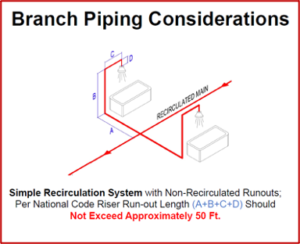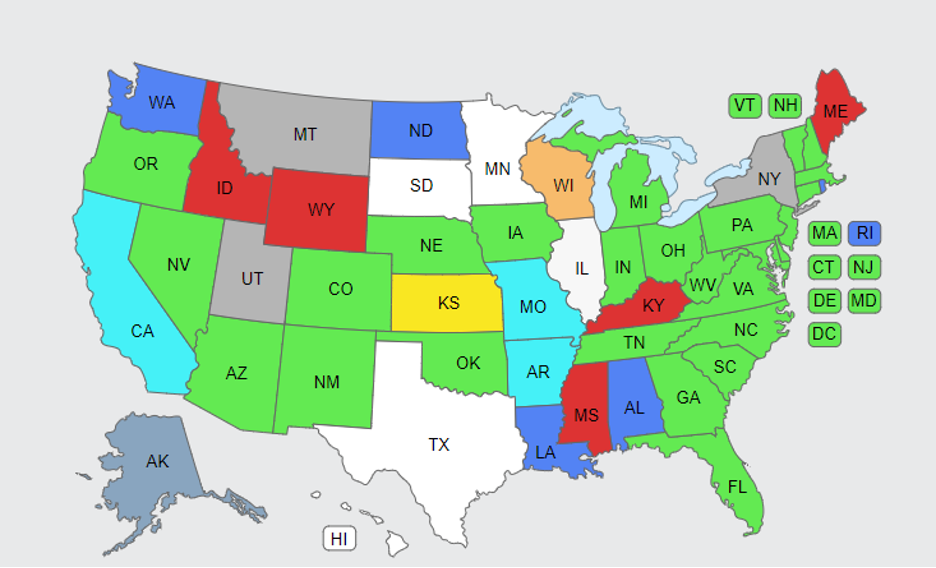In the 04-05-2021 Monday Morning Minutes, we asked for your opinion on the length of the domestic water recirculation line from source to fixture. Here are some of the comments we heard.
A Variety of Codes and Comments
There are a variety of suggestions about the pipe length and design from the LinkedIn post, the ASPE Connect post, as well as emails received from many of you. This could be the Monday Morning “Hours” instead of minutes if I showed all the comments but here are a few.
R. L. Deppmann represents products in Michigan and Northern Ohio. Given that, I will lead with a comment from the president of the Eastern Michigan Chapter of the American Society of Plumbing Engineers (ASPE). Pam Hartsell, of Strategic Energy Solutions in Berkley, MI. She agreed with the concern about the length of pipe and the time it takes to get hot water at low flow lavs. In Michigan, the State code is still 50 feet.
Victoria Johnson, of Bass, Nixon, and Kennedy in Raleigh, NC, posted a great summary of the issue. She mentioned a 3-second rule. Many of us know the 3 second rule in driving but she referred to it in the post. The calculations she posted indicated up to 6 minutes of wait time for hot water at a ½ GPM Lavatory. Clearly worst at ¼ GPM. Much longer than 3 seconds to wait for hot water.
There are a variety of responses on the posts. Two standards or guidelines were voiced and supported by many. Here is a quick review of these top two offerings.
2018 International Energy Conservation Code (IECC)
The 2018 IECC standards limit the volume of water from the source to the fixture based on type of building, public or other. That volume helps assure hot water in a timely manner.
Rick Hautekeete, a mechanical engineer at McClure Engineering in St. Louis responded to the discussion on the ASPE Open Forum. They use section C404 of the 2018 International Energy Conservation Code (IECC).
Rick indicated the need for shorter recirculation lines. He remarked, “There is no state code in Missouri, so it varies by municipality, but even where it is not code, it is good practice. I remember my first LEED project with 0.5 GPM lavatories and complaints from the owner on how long it took to get warm water, which was a valid complaint”.
He also indicated the IECC comes with other requirements that become a challenge at times.
Several engineers responded that they use this standard.
2018 Facility Guidelines Institute
James Dudt, principal at Karpinski Engineering, solves the issue by using the Facility Guidelines Institute (FGI) 2018 edition of their guidelines. This addition requires a maximum of 25 feet for the dead leg of a domestic hot water recirculation line from source to fixture. The proposed, but not final, 2022 guidelines change that length to 10 feet.
The FGI site shows an interactive map of the United States regarding compliance. A photo of the April 2021 map is shown below. Visit the link and click on your state for more information. The map is dynamic and changes as codes and usage changes so the site is the best resource.
Summary, What Can We Do?
Providing warm water goes a long way to allow an occupant to complete a healthy 20-second wash. Shorter dead legs can contribute to healthier water quality at low-use fixtures. Lack of hot water may affect the owner’s opinion of the engineer.
Providing the minimum required by code means little to the person at the lavatory who is unable to wash in hot water. Offering owners an alternative design and the cost impact will indicate how much you care about their needs. Help the owner to choose whether faster delivery of hot water trumps their first cost concerns.
Eric Rogers, the Senior mechanical project engineer, summed up with this post, “It’s 2021 and the 50′ rule of thumb doesn’t work anymore”.
We need the State and Municipal lawmakers to understand how lengthy deadlegs contribute to waste of water resources, waste of employee time, and the health of occupants.
Please keep looking at the two public posts for more comments on this timely subject.




